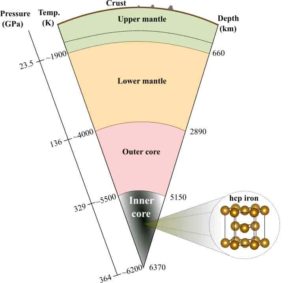
A theoretical mineral physics approach based on the ab initio methods was adopted to determine the viscosity of hexagonal, close-packed iron at the extreme pressures and temperatures corresponding to the Earth’s inner core. The results are found to deny geophysical observations of large fluctuations in the inner core rotation rate. The obtained viscosity also rules out inner core translation and provides support that the dynamics of the inner core may be governed by solid-state convection.
The Earth’s inner core, hidden 5150 km below our feet, is primarily composed of solid iron and is exposed to pressures between 329 and 364 GPa (which are ~3.3 to 3.6 million times that of atmospheric pressure) and temperatures of ~5000 to ~6000 K (Image 1). Seismological observations previously revealed that the velocity of seismic waves produced by earthquakes depend strongly on their direction when traveling through the inner core, a phenomenon known as “seismic anisotropy.” This is due to the alignment of the iron crystals, something that may be caused by deformation inside the inner core. More specific variations in seismic anisotropy between the eastern and western hemisphere of the inner core have also been reported. Other seismic studies furthermore suggest “distinct fluctuations in the inner core rotation rate” with respect to that of the Earth’s crust and mantle. Although previous geodynamic modelings predict that the hemispherical asymmetry of the seismic anisotropy structure can be explained by “a translational motion of the inner core” and that variations in the length of a day can be explained by the gravitational coupling between the mantle and a weak inner core, the causes and mechanisms of these enigmatic features remain unclear because their modelings rely on the poorly constrained “viscous strength” of iron at the extreme conditions of the Earth’s center.
The viscosity of the materials depends on the way iron crystals undergo plastic deformation in response to a mechanical stress, and deformation mechanisms called “creep” are generally expected under high-temperature and small stress conditions. Creep of solid crystals is generally accommodated by the motion of imperfect arrangements of atoms in the crystal structures called “lattice defects” and is particularly limited by “atomic diffusion” under the conditions of the inner core. Such conditions impose technical difficulties on laboratory experiments making measurements of the inner core viscosity currently impossible. Instead, Dr. Sebastian Ritterbex, a post-doctoral researcher, and Prof. Taku Tsuchiya from the Geodynamics Research Center, Ehime University, applied atomic scale computer simulations based on quantum mechanics theory, called “the ab initio methods,” to quantify atomic diffusion in hexagonal close packed (hcp) iron, the most likely phase of iron stable in the inner core.
This theoretical mineral physics approach can compute electronic properties and chemical bondings highly accurately and thus is quite powerful in investigating material properties in extreme conditions which are difficult to handle by experiments. In this study, the technique was applied to compute iron self-diffusion through energetics of the formation and migration of point defects. Results are applied to macroscopic models of intracrystalline plasticity to compute the rate-limiting creep behavior of hcp iron numerically. The modeling provides evidence that the viscosity of hcp iron is lower than postulated in the previous geophysical modelings and determined by the transport of shear through the crystal lattice, a plastic deformation mechanism known as “dislocation creep”, which can lead to the formation of crystallographic preferred orientations. This suggests that plastic flow of hcp iron might indeed contribute to the crystal alignment and thus the seismic anisotropy in the inner core.
The results shed new light on the enigmatic properties of the inner core. The researchers demonstrate that the low viscosity of hcp iron derived from the theoretical mineral physics approach is consistent with a strong coupling between the inner core and mantle compatible with geophysical observations of small fluctuations in the inner core rotation rate. The results furthermore predict that the inner core is too weak to undergo translational motion, meaning that the hemispherical asymmetric structure is likely to have another, yet unknown, origin. Instead, mechanical stresses of tens of Pa are sufficient to deform hcp iron by dislocation creep at extremely low strain rates, comparable to the candidate forces able to drive inner core convection. The associated viscosity is not a constant but instead depends on the mechanical stress applied to the inner core, a behavior known as “non-Newtonian rheology.” This nonlinear deformation behavior is therefore expected to govern the dynamics of the Earth’s inner core.
In the future, more quantitative modelings using the viscous properties of hcp iron obtained in this study could enhance the understanding of the Earth’s inner core.
The study is published in Scientific Reports.
Reference:
Sebastian Ritterbex et al. Viscosity of hcp iron at Earth’s inner core conditions from density functional theory, Scientific Reports (2020). DOI: 10.1038/s41598-020-63166-6
Note: The above post is reprinted from materials provided by Ehime University .










